How to Grow a Moringa Plant Successfully from Seed
How to Grow a Moringa Plant Successfully from Seed to Tree
Growing Moringa is highly rewarding as it offers a wealth of nutritious and versatile elements such as its edible leaves, seeds, and oil. Growing Moringa from seed is a simple and straightforward process, but it does require some patience and proper care. In this guide, we’ll show you step by step how to grow a Moringa plant successfully from seed to tree.
Moringa seeds are chosen based on their size and color. The first step in growing a healthy tree from quality seeds is the germination of Moringa seeds. To expedite germination, soak the Moringa seeds in water for 24 hours. The following day, remove the soaked seeds and place them on a damp paper towel or cotton cloth. Wrap them and tie a knot around the bundle. Store this bundle in a dark place inside a container. It typically takes about one week for the seeds to begin sprouting. Ensure that the paper towel or cloth remains moist during this period.
Once the seeds have sprouted, plant them in a 4-inch clay pot with the green sprouts facing upwards at soil level. After about one month, check if the plant roots are emerging from the bottom of the pot. At this point, you can transplant the growing Moringa plant into a larger pot with a capacity of around 12 liters. This pot will suffice for the plant’s growth for approximately one year. If you intend to transfer the Moringa tree to the ground, it can remain in the 12-liter pot for up to six months before transplanting.
What is Moringa and Why Should You Grow it?
Moringa (Moringa oleifera) is a highly nutritious and versatile plant that is widely grown for its edible leaves, seeds, and oil. The tree is sometimes referred to as the “Miracle Tree” or the “Tree of Life” due to its numerous health benefits and diverse uses.
The leaves of the Moringa plant are a rich source of vitamins, minerals, and antioxidants. They contain high levels of vitamins A and C, calcium, and iron, making them a nutritious addition to a variety of dishes. The leaves can be eaten raw or cooked, and they are commonly used to make soups, stews, and teas. The leaves have a slightly bitter taste and are often compared to spinach or kale.
In addition to its leaves, Moringa seeds are also highly prized for their oil, which is used in cosmetics, soap-making, and cooking. The oil is high in monounsaturated and polyunsaturated fatty acids, making it a healthy alternative to other oils. The seeds can also be pressed to produce a high-quality edible oil that is used in cooking and as a base for many other products.
Moringa is easy to grow and is highly adaptable to a variety of climates and soils. It is a fast-growing tree that can reach maturity in just a few years, making it an excellent choice for those looking to add a nutritious and sustainable food source to their garden or homestead. Additionally, Moringa is drought-resistant and can grow in areas with limited water resources, making it a valuable plant for regions experiencing food insecurity or water scarcity.
Growing Moringa is not only an excellent way to add a highly nutritious and versatile food source to your garden, but it can also help contribute to global food security and sustainability.
A nutrient-rich herb called moringa has been utilized for both culinary and medicinal purposes for generations. The “miracle tree” is renowned for its abundance of antioxidants, vitamins, and minerals. Moringa leaves, pods, and seeds can be used to make tea, powder, or capsules in addition to being consumed raw or cooked.
Protein, fibre, vitamins A, C, and K, as well as minerals like iron, calcium, and potassium, are all present in good amounts in moringa. Additionally, it has antioxidants that can help shield the body from harm caused by free radicals. Numerous health advantages of moringa have been demonstrated, including:
lowering blood sugar levels, improving digestion, strengthening the immune system, preventing heart disease, battling cancer, and lowering blood pressureencourages weight loss
People of all ages can benefit from the safe, adaptable moringa plant. It is a beneficial complement to any diet and may keep you strong and healthy.
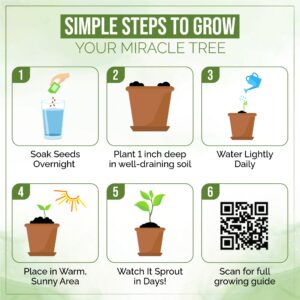
Understanding Moringa’s Growing Conditions
Moringa is a plant that thrives in warm and humid conditions, making it ideal for growth in tropical regions. TPlace Moringa in an area that receives full sun exposure, as this plant needs plenty of sunlight to thrive. Additionally, it is important to plant Moringa in well-drained soil, as the plant does not tolerate standing water, which can lead to root rot. Moringa can grow in a variety of soils, including sandy and clay soils, but it is important to make sure that the soil is well-draining.
Protect Moringa from frost, as it does not tolerate cold temperatures. Frost poses a threat to Moringa and temperatures below freezing can swiftly harm it. To ensure the success of growing Moringa, it is recommended to plant the seeds in an area that is protected from harsh winds and cold temperatures, or to grow the plant in containers that can be brought indoors during periods of cold weather.
Overall, Moringa is a highly adaptable plant that can be grown successfully in a range of growing conditions, as long as the plant is provided with plenty of sunlight and well-draining soil. By providing the right growing conditions, you can ensure that your Moringa plant will thrive and produce nutritious leaves, seeds, and oil for you to enjoy.
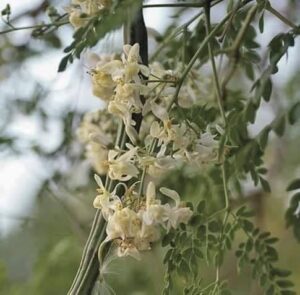
Obtaining Moringa Seeds
In order to obtain Moringa seeds for planting, you have the option of either purchasing them online or at a local plant nursery. Online retailers provide a vast range of Moringa seeds, simplifying the search for the ideal type for your requirements. Some online retailers also offer organic Moringa seeds, which are ideal for those who are looking for an eco-friendly option. Local plant nurseries are another great option. They often have a good selection of seeds and can provide you with advice on the best variety for your growing conditions.
It’s crucial to ensure the freshness of Moringa seeds when buying them. As old seeds can result in poor germination rates. Verify the freshness of Moringa seeds before buying by ensuring they haven’t been kept for a long time. Stored seeds can have a lower germination rate, meaning that fewer seeds will sprout and grow into healthy plants. To ensure optimal growth and results when planting Moringa. Choose seeds that are fresh and haven’t been kept in storage for an extended period. Opt for seeds that have been harvested recently or have been kept under optimal conditions to maintain their vitality. It’s also a good idea to purchase seeds from a reputable source. As this will give you the best chance of growing healthy and productive Moringa plants.
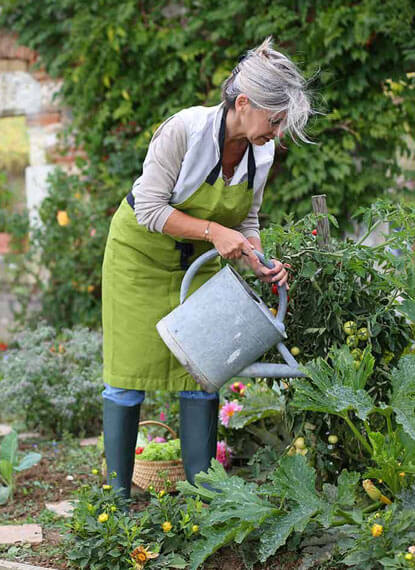
Preparing the Soil for Planting
You can easily plant Moringa seeds in your home garden or in containers. In order to ensure the best results, it is important to properly prepare the soil before planting. To cultivate healthy Moringa plants, enrich the soil with compost or organic matter and plant the seeds about 1/2 inch deep in the well-drained soil. This will provide the young plants with the necessary nutrients to grow strong and healthy. To prepare the soil, dig a hole about 6 inches deep and mix in compost or organic matter.
Then, fill the hole with soil and water thoroughly. This will help to settle the soil around the seeds and provide the necessary moisture for germination. After planting the seeds, be sure to water them regularly and keep the soil moist. With proper care, the Moringa seeds should germinate within a few days to a week and begin to grow into healthy seedlings.

Planting Moringa Seeds
When planting Moringa seeds, it is important to follow the proper steps to ensure successful growth. Plant Moringa seeds 1/2 inch deep in well-prepared soil that has been enriched with compost or organic matter to ensure their proper growth. After planting, it is important to cover the seeds with soil and water them thoroughly to help them establish roots. When planting multiple seeds, it is important to space them about 6 inches apart to allow room for the seedlings to grow and develop. Additionally, it is important to provide the Moringa plants with adequate water and sunlight to promote healthy growth. With proper care, the Moringa seeds will germinate and grow into healthy, productive trees that can provide you with nutritious leaves and oil for years to come.
Caring for Moringa Seedlings
As Moringa seedlings are in the early stages of growth, they are particularly vulnerable and require consistent care to establish themselves and grow into healthy mature trees. Providing the right growing conditions is crucial to the success of Moringa seedlings.
Moisture is essential for Moringa seedlings, as they need it to absorb the nutrients they need for growth. It’s important to water them regularly and make sure the soil stays moist but not waterlogged. Over-watering can lead to root rot and kill the seedling, so it’s important to find the right balance.
Light is also an important factor in the growth of Moringa seedlings. Place the Moringa seedlings in a location that receives full sun to ensure they receive enough light for strong and healthy growth. However, strong winds can be harmful to the delicate seedlings, so it’s important to protect them from excessive wind exposure.
The proper care and maintenance of Moringa seedlings is essential to ensure that they grow into healthy mature trees that can provide nutritious food and other benefits. By providing consistent moisture, light, and protection from strong winds. You can give your Moringa seedlings the best chance for success.
Transplanting Moringa Seedlings
It is important to handle the seedlings carefully when transplanting them to avoid damaging their delicate roots. Make sure the soil is loose around the root ball and gently spread out the roots in the new pot or in the ground. Water the seedling well after transplanting to help it settle into its new home. Once transplanted, continue to provide the seedling with consistent moisture, full sun, and protection from strong winds. Regular watering, fertilization, and proper pruning will help the Moringa tree establish itself and grow strong and healthy. With the right care, Moringa can grow up to 10 feet or more in just a few years, providing an abundance of nutritious leaves and seeds for use in food and wellness products.
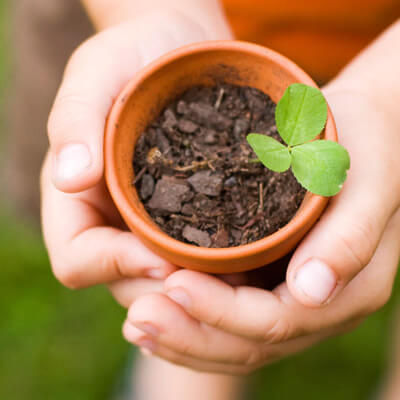
Continued Care for Moringa Trees
Growing Moringa seedlings requires consistent attention and care during their early stage of development. Ensuring the right growing conditions is critical for the success of Moringa seedlings.
The seedlings need consistent moisture to absorb the essential nutrients for growth. Regular watering is crucial, but it is equally important to avoid over-watering, as it can lead to root rot and kill the seedling. Finding the right balance is key.
Adequate light is also a crucial factor in the growth of Moringa seedlings. Protecting Moringa seedlings from strong winds is important for their growth, as it helps to preserve their delicate nature. The ideal growing location for Moringa seedlings is in full sun, where they can receive ample light to thrive.
In conclusion, proper care and maintenance are critical to ensuring that Moringa seedlings develop into healthy, mature trees that can provide nutritious food and other benefits. By providing consistent moisture, adequate light, and protection from strong winds. You can set your Moringa seedlings on the path to success.
Harvesting Moringa Leaves and Seeds
You can start harvesting Moringa leaves as soon as the trees establish themselves. Which typically happens within a few months of planting. You should harvest the Moringa leaves by snipping off the tips of the branches. Ensuring that enough foliage remains to keep the tree healthy.
To collect the Moringa seeds, simply gather them from the ground once they have turned brown and fallen from the tree. Collecting the seeds is a simple process, simply gather them from the ground and let them dry completely before storing them.
When grown with proper care and attention, Moringa can become a healthy and productive tree within a few months. Not only does it make for a beautiful addition to a home garden. But its leaves and seeds offer numerous health and culinary benefits. With its numerous benefits, Moringa is a plant that is definitely worth growing in your garden.
References
Moringa Seeds | Non-GMO Heirloom Vegetable Gardening Seeds · True Leaf Market
Moringa With Barry stores offer a variety of moringa products. These include: Moringa Powder, Moringa Tea, Moringa Capsules and Moringa Oil.
Read more:
Safety of Moringa Seeds: Are They Safe to Eat?
Health Benefits of Moringa Seeds: Exploring Their Goodness
Water Purification with Moringa Seeds: A Natural Solution
From Harvest to Powder: The Process of Making Moringa Powder
Harnessing the Power of Moringa Powder: Practical Uses and Benefits



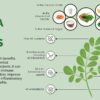

2 Comments